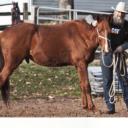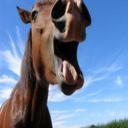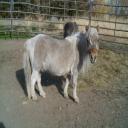Yahoo Clever wird am 4. Mai 2021 (Eastern Time, Zeitzone US-Ostküste) eingestellt. Ab dem 20. April 2021 (Eastern Time) ist die Website von Yahoo Clever nur noch im reinen Lesemodus verfügbar. Andere Yahoo Produkte oder Dienste oder Ihr Yahoo Account sind von diesen Änderungen nicht betroffen. Auf dieser Hilfeseite finden Sie weitere Informationen zur Einstellung von Yahoo Clever und dazu, wie Sie Ihre Daten herunterladen.
How best to extinguish head slamming?
We have some ponies and horses that hit us with their heads when being led. We have had only partial success, having used either pushing the head away or pulling the rein on the off side. The pulling method is not easy to reach, and is only good if the horse is bitted. We feel that punching the horse is counterproductive. We must be overlooking some technique that we already know, or should know. I am already thinking, "What would I say if someone asked me this question?" but am drawing a blank.
Does anyone have a good suggestion?
Lots of good suggestions thus far, several with thumbs in various directions. Some are ideas we've not tried. I've not given any thumbs yet. I suspect that the best answer may be selected by my horses and ponies, if we find that something works well.
8 Antworten
- CarlLv 5vor 4 Jahren
I don't correct unwanted behavior, I prevent unwanted behavior before it happens. It's all about awareness and timing. The horse is extremely aware of what you are doing and if your mind wanders the tiniest amount, the horse knows this and may decide to make sure whether or not you're really with him. One way the horse does this is to see if he can cause you to move. That's what he's doing when he slings his head at you.
Many times I've had people ask me about problems they have leading their horse. I'll ask them to lead their horse so I can see what's going on. Most of the time, what I see is that they're not really leading the horse, they're just walking the horse form here to there. Their mind is on where they're going, but they have no mental connection to the horse. The horse knows this, The horse needs to know that someone is in charge, if the person isn't staying connected to the horse, mentally, well, that horse can test that person in ways that can be surprising.
When I am with a horse, I am with that horse 100%. The horse knows this. If I have to talk with someone or do something while I'm with the horse, I still stay mentally connected with the horse, I know what he's doing at all times, just like the horse knows what I'm doing at all times.That's the awareness I'm talking about. It's not easy, but, I feel it's necessary. The timing comes in when the horse, maybe, wants to check to see if I'm really with him. If my awareness is where it should be, I can tell when he's looking to check this out. Then, before he acts on this notion, I can wiggle the lead rope or make some movement towards him, that he understands that says to him, I'm still with you, and still in charge. I can cause the horse to move, he can't cause me to move. Ultimately, the horse is happy with this arrangement.
It's a lot more mental than it is physical. Many people don't get that. The horse does, every time.
Let me add a little something here pertaining to respect, or the lack there of.
This is something I see a lot with people and their horses. The problem, sometimes, is that people get it kind of backwards. They want to demand respect from the horse, and in the attempt to achieve this, they, kind of, get after the horse, thinking they have to tell the horse, "RESPECT ME, DO WHAT I SAY, WHEN I SAY IT, OR ELSE!" Demanding respect, like this, doesn't really work. Sure, you can get the horse obedient this way, but it's not out of respect, it's out of fear. I've found that to get respect from a horse, or people for that matter, you must offer them something to respect. In case of horses, it's by being a solid leader, and understanding how the horse feels and thinks about things. I'm not saying I never use firmness with a horse, I do, when it's needed, but it's not used in anger, or out of frustration. The instant the horse starts to give to that firmness, it goes away.
- JeffLv 7vor 4 Jahren
wow...seems some one never taught the horse to respect space. If you understand moving pictures Clinton Anderson puts a ton of lessons out for respect and issues like yours.
Key point... the horse gets in your space take over and move him out of it... I like to move the hip... make it worth your time too. Left and right a couple of times... then move back to your spot and when the horse crowds you ... do it again. Horses put this pressure and release and moving feet at the leaders choice as gospel. If worse come to worse... let them run into the tail of the lead rope your swinging like a propeller ... of course when a horse has become habitual in this kind of thing and you need to make it happen "now" for some reason... pop the end of that lead on the nose....
- Amazing GraceLv 5vor 4 Jahren
Where are you on the lead rope?
Most people do not have near enough drape in the rope.
If you are leading the horse like they do in horsemanship classes in the horse shows you are too darned close to the horse and probably actually pulling it into you.
Do not walk in front of the horse. If the horse becomes startled or spooks at anything it is going to be right on top of you!
I like my horse's head about at my shoulder and about two feet off, because I give the horse visual cues. Our horses will all lead from either side yielding stopping and backing up on no contact at all. It's like a dance and it is SAFE and easy to do. I have seen pro trainers let the horse move out a little farther in front and that is OK too but I prefer them to be just a bit back.
Just no horse right behind you.
Them rubbing on you is DISRESPECT 101.
Get some ground manners in place.
Jeff is absolutely right!
Here's a good visual for the folks who are not "getting it".
- vor 4 Jahren
Easy, make them walk behind you. Many people lead at the shoulder but you don't have to. To have the horse lead behind you, start them there and when they go to speed up, use the end of your lead to twirl it at them (suggest) and then strike them with the lead on the chest (ask) or the face or neck or whatever is speeding up past you to get them well back (tell). Or if they don't listen to that turn on them and back them vigorously while giving them the stink eye and basically chasing them out of your space using any means available to you (command). I know the stink eye itself doesn't hurt that much but when I bring it out for example it means life is going to be difficult for you because you just made a seriously rude error of judgement and I'm about to bring out lead mare witch to mule kick back to next Tuesday if you don't listen. All I have to do is glare now and they kind of make this little surprised hop and snap to attention. Use a 12 or 15 foot lead if you have it for the extra length. Also, block them with your knuckle, elbow, knee or boot if they get anywhere near you. Throw it up there and let them run into it. If you lead while flapping your elbows randomly, they know if there head is anywhere near than nearly arms length radius of you they might get bumped. Also, if you are leading them behind you twirl your lead in front of you in a little vertical helicopter so their nose can't get ahead without getting popped by the twirling lead.
- Wie finden Sie die Antworten? Melden Sie sich an, um über die Antwort abzustimmen.
- ?Lv 6vor 4 Jahren
you raise an elbow they will bump into it. Make sure to enforce the rule" No touching the human" by whatever means you need to get the point across. Make sure the horse is the one moving out of space you both occupy. whomever is moving away is the loser in the horses way of doing things.
- JoeLv 7vor 4 Jahren
I don't know if this will work, but I'll tell you the story.
When my horse was five (and still new to me), he got a little nippy on the lead. I started leading him from the right side: no nipping. We did that for a while. Then, when I started leading him from the left again, he was no longer nippy on that side.
I was very pleased that it worked! Maybe it will work for you.
EDIT:
TDs? It worked, quickly and easily, and it was safe. My only regret is that I didn't maintain the easy leading from the right when asked for. That can be useful.
- partly cloudyLv 7vor 4 Jahren
I have used Joes method of leading from the off side. worked like a charm!
- Anonymvor 4 Jahren
Stick your elbow out so when the horse invades your space, he pops himself in the face with your elbow.






